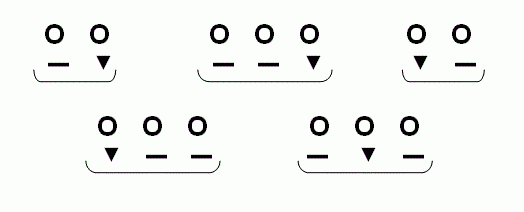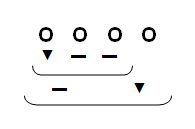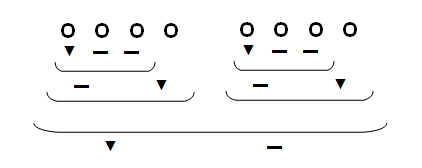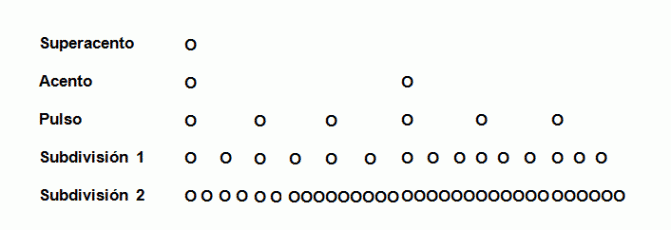Parts of the book by BARRETTA, C., MIRAMONTES, L., & ZORRILLA, A. (2013). Ritmando Danzas. Buenos Aires : Autores de Argentina. Translation by Gustavo Long, terminological and stylistic revisión by Mariana Migliore.
Definitions of the concept of rhythm. Plato, Benveniste, physiological rhythm, and others.
“Quid est ergo tempus ? Si nemo ex me quærat, scio ; si quærenti explicare uelim, nescio (What is, then, the time ? If no one asks me, I know it ; but if I want to explain it to the one who asks me, I do not know)”. Saint Augustine of Hippo. Cfr. Confessions. XI, 14, 17.
A similar feeling of surprise and astonishment occurs when looking up a definition theory faces the experience of rhythm. What is rhythm ? The first impression is that it is something everybody has experienced. Its concept is simple and natural. The word rhythm is in everyday language. It is used in many common situations and found in texts that talk about subjects like meteorology, economy, medicine, physics or politics. Furthermore, it is a very common subject in conversations about art works or other phenomena that have an aesthetic aspect, such as TV shows, newspaper articles, journeys or even natural phenomena like the movement of sea or fire, among other things. There is almost no context in which rhythm would be a foreign concept.
However, the dominant impression is that of strangeness and astonishment that St Augustine describes so simply as regards to time. Which is then the cause of such a contradiction ? How can it be that it is so difficult to define such an ordinary word ? Without a doubt it is not an isolated case. There are many other words in everyday language as difficult to define but not impossible like in this case. Going back to the rhythm discussion, the familiarity with the experience and the frequency of the use of the word hides the complexity of the phenomenon. Many of the definitions make reference to different aspects of the rhythmic experience, taking a part of it and avoiding the rest. For example, when talking about cardiac rhythm, reference is made to the frequency of a repetitive event, the length, and the repetition. On the other hand, when talking about the rhythm of a scene in a thriller film, the repetition, for example, may not be an outstanding aspect.
This discussion is clarified a bit when two issues are distinguished. First, the semantic aspect, that is to say, what object is named through the use of the word, and second, the ontological aspect, what is the object in its own, independently of the term which it is named with. The naive thinking about the realistic view that this distinction implies, will not be treated in depth in this essay. In any case, it is good to point out that the focus of this investigation is more phenomenological, meaning that instead of trying to define the object on its own, if existing, priority will be given to the description of its characteristics.
The French philologist Emile Benveniste (BENVENISTE, 1966) already made a classical study about the etymology of the term. In it, he demonstrated that the association that the French dictionaries make between the Greek word “rythmos” and the movement of the waves at the seaside, although convincing at first, it is unsustainable if studying the use of the term in texts. This author distinguishes an evolution of the meaning from its more ancient appearances and the more modern ones. Among Ionic philosophers, like Leucippus and Democritus, but also in Herodotus, the word appears, surprisingly for us, meaning “shape”. It appears related to objects which have changing shape, for example, the shape of the letters of the alphabet, the human character, the image that the mirrors reflect, the shape of an opinion, of a thought. That is why for Benveniste, the old meaning of the word is the “peculiar way of flowing”, or “shape that becomes what moves, changing, fluid”. Later on in Plato’s texts, the word has a new meaning. Apart from the previous meaning, it refers to the human movement put down to the number : “the shape of the movement that the human body takes in dance, and the disposition of the figures in which the movement determines”. The crucial innovation is the association between this “disposition”, that is to say “rhythm”, to the “meter”, and its submission to the laws of number. “It is the order in the movement, the entire process of the harmonious conformation of the corporal attitudes combined with a meter which from then on is referred to as rhythm”.
In the last paragraph of his article, Benveniste makes, in our opinion, a very important contribution. He says “…it is not in the contemplation of the movement of the waves at the seaside, the primitive Hellene discovered the “rhythm” ; on the other hand, we are those who nowadays metaphorize when we talk about the waters. … Nothing has been less “natural” than this elaboration… of a notion which seems so necessarily inherent to the articulated shapes of the movement that we can hardly believe, that we have not taken conscience from the beginning.” (BENVENISTE, 1966, p. 333 - 335)
The current ideas about rhythm are full of concepts in which the same reflection can be applied. There is nothing “natural” in the classification of certain aspects of the rhythmic phenomenon in connection to others. There is nothing natural in the events that take place at regular intervals. Nor in the expectation that after two comparable events separated by an interval of time, a third one would happen after an equivalent or similar interval. There is no reason to consider repetition more natural than variety, nor the regularity than the irregularity, nor the satisfaction of one’s expectations than the surprise. The idea that there is something “natural” in rhythm, that has to be known and internalized, is an obstacle of the type described by Gaston Bachelard in The Formation of the Scientific Mind.
For example : “…the scientific spirit must be educated against nature, against what it is inside and outside of us, impetus and teaching of nature, against of natural enthusiasm, against the coloured and various facts. The scientific spirit must be educated re-educated itself.” (BACHELARD, 2000, pág. 27) He also emphasizes the obstacle that assumes the acquired knowledge about the studied object for advancing in knowledge : “...Then, it is impossible to do Tabula Rasa with the usual knowledge. Facing reality, what it is supposed to be clearly known bewilders what it should be known. When presented to scientific culture, the spirit is never young. It is even old, because it has the age of its prejudices. Having access to science is to rejuvenate spiritually, it is to accept an abrupt mutation that contradicts a past.” (BACHELARD, 2000, p. 16) Although Bachelard talks about science, this point of view can spread out to others disciplines such as Art Theory, Didactics, and others.
Since Plato’s definition, that rhythm is the corporal movement organized in time, it was generalised that the meaning of the word rhythm is to define every regular phenomenon. In general, this is what is called rhythm in physiology, physics, economics, astronomy, and other sciences, but also in art. Thus, in music rhythm equals to the speed of the beat, in poetry to the number of syllables that exist between the grammatical accents. Even in architecture it refers to a series of columns separated by equal distance, or in painting figures that are repeated regularly.
It is also said that a novel, theatre, or a film have rhythm. In those cases, the meaning of the word must change, considering that the majority of times, phenomena that repeats at regular intervals of time does not exist. Moreover, the condition that Barbieri establishes when talking about rhythm : “...a recurrence of equivalent elements” (BARBIERI, 1992, pág. 9) seems excessively restricting in many occasions. Many times in a novel, to give any example, rhythm is referred as the way that the tension of the stories are connected. How an event is solved in other one, how a group of argumentative threads are conjugated in a plot that for certain moments are increased, in others are accentuated, and finally are solved (or not). In other cases, rhythm is defined as the particular way of constructing a prose, the way in which the actor represents the changes of emotions of the character, a characteristic order in which images are placed in a film. In these cases, it seems other ideas of rhythm are need, based on other phenomena.
The American philosopher Susanne Langer, whose aesthetic-philosophic programme consisted in defining the “essence” of arts and their phenomena, says : “The essence of rhythm is the preparation of a new event through the ending of a previous one. A person that moves rhythmically does not need to repeat exactly any of its movements. These, however, must be finished gestures, in order to feel its beginning, its purpose and its consummation, and identify in the last stage of the movement, the condition and the fact the beginning of another one. The rhythm is the establishment of new tensions in the ending of the previous ones. Definitely, they do not need being of equal duration, but the situation that origins the new crisis must be inherent to the end of the previous one”. (LANGER, 1953, pág. 121)
In that sense Pascal Michon asks : Can we, in view of our analytic necessities and the big diversity of process that concern them, be satisfied by the traditional meaning inherited by Plato ? Do we, by the contrary, adopt a more global definition, about the model that Benveniste suggests in his seminal article “The notion of rhythm in its linguistic expression” ? Thus, the concept of rhythm, shouldn’t it be re-defined as ‘rhuthmos’, that is to say, ‘a specific way of flowing’ ? “. Wouldn’t it help us, as a tool for thinking at the same time of a metric succession and all other forms of possible organization, independently of meter ?” (MICHON, 2010)
When referring to metric, like in the case of musical beats, or in the poetry of feet, or in the counting of dance, the description of rhythm, being complex and in need of much more training, is perfectly possible and usual. But when talking about the rhythm of the big scales, or in the framework of works that do not show regularities, nor recurrences, nor equivalent elements, in general one resorts to metaphoric descriptions, rich in suggestions and connotations ; many times very emotional, but not based on easy manipulated concepts or theoretically productive.
Barbieri asks “…how is it possible to make a more formal and controllable description of rhythm” (BARBIERI, 1992), that allows a more complex elaboration, that opens the opportunity to other possibilities of approaching the phenomenon and build a theory over it. In addition, Henri Meschonnic points the obscurity he sees in big dimension rhythms : “In the speech, the speech is rhythm and rhythm is speech… The rhythm is a concise combination of all the elements that contribute to its formation, an organization of all units… from the phrase to those which belong to the story… This poses a problem, of which nothing is known : the relation between the small units and the rhythm of the big ones…” (MESCHONNIC, 1982)
Leonard Meyer presents a definition of rhythm based on the phenomenon of grouping : “...rhythm may be defined as the way in which one or more non accentuated parts are gathered in relation with another part that it is accentuated”. (COOPER & MEYER, 1960) We think that this definition, very technical and restricted to music, is very interesting. It prioritizes the phenomenon of grouping, unusual in texts that talk about rhythm. This limits the effect of the term to one of the components of a more complex fact, and it has the advantage of moving away from the idea of repetition and regularity so overvalued. If we think of the shape that acquires that what changes with time, taking up again the notion of Benveniste, we believe that this reorganization may be the base of a formal manipulable and productive description for the theory and practice of rhythm.
Regardless, under all these definitions lies the idea of rhythm being an external event, that somehow is “discerned”, or that the subject, as sometimes is said, takes part. However, in this conception defined in this essay, rhythm is always an action of the subject, it is something that people “do”, as interpreter, creator, or public. Fraisse says : “...in certain grade, rhythm is discerned and it is made (by who discerns it) at the same time”. (FRAISSE, 1976, pág. 14) The fact that this rhythmical action is made in relation with an art work does not imply that the rhythmical “reality” is in the work and being perceived by the subject. It is the action of the subject, in relation to the work, the one that constructs the rhythmical experience.
In that sense, the French author Henri Meschonnic gives this definition : “I define rhythm in language as the organization of the marks in which the linguistic and extra-linguistics significants, produce specific semantics, different to lexical sense, and that I call “Signifiance” that is to say, the own values of a discourse”. (MESCHONNIC, 1982) (The French term “Signifiance” has in this work a specific meaning defined by the author) In a subsequent work in collaboration with Gérard Dessons quoted in an article of Eric Bordas can be read : “...Rhythm is understood as...the organization of the movement of word by a person” (DESSONS & MESCHONNIC, 1998) ; “...idea that has the merit of putting the person in the centre of the reflection.” (BORDAS, 2007)
Pierre Sauvanet, in an article about the work of Henri Maldiney, without translation to Spanish and that appears in the specialized website Rhuthmos, describes in this way the rhythmic experience and the participation of the person : “Experimenting a rhythm, is make it of oneself. Mastering a rhythm is being mastered by it. Having rhythm is being it. The psychoanalyst and phenomenologist Nicolás Abraham created a theory of this type of conscience, that he called “Rhythming Conscience”, which cannot be omitted. The perception of a rhythm is in reality a “rhythmization” of the perception. And what is suppose of being a game in rhythm is at the same time the position of the subject and its displacement, its location outside of centre. The mark of the subject, because there is no rhythm without subject that discerns it or makes it. But also its perturbation, because there is no rhythm without rhythmed subject, without “rhythmization” of the subject in exchange.” (SAUVANET, 2012)
Oscar Araiz, in an interview that he gave us for this research, says that “... in each work [rhythm] creates a bond with the attention, it wakes up, it makes it rest, it actives it again, it surprises it, or can be intolerably tedious. What is interesting in that bond is that the unique point of contact with a possibly active attitude in the spectator.” (ARAIZ, 2007)
In this essay, Pascal Michon’s suggestion quoted above will be followed, considering the rhythm as “the form of what flows”. The reason for this is because it is an all-embracing idea that can include particular cases such as the metric phenomena, the periodic ones, the proportional ones, and also the non-metrics ones, the aperiodic ones and the immeasurable ones. The characteristics of the rhythmic experience will be studied, starting from the idea that many of the definitions are different and apparently excluding one from another. They approach the phenomenon from several angles and prioritize different aspects.
Grouping and levels of organization
“The essence of rhythm is the preparation of a new event through the ending of the previous one”, said Susanne Langer in a fragment quoted above. This author does not talk about grouping, but this quote appears as a complete description of how two events are “grouped” rhythmically.
Very different is the definition of Fraisse, that depends entirely on the “physiologic” idea of the rhythm : “Grouping and rhythm are different notions” (p. 69), and “Grouping is the principal characteristic of our perception…In rhythm, we always find structures linked of isochrones intervals” (p. 71). This last definition depends entirely on the adopted definition of rhythm. And the description of grouping as a characteristic of the perception comes up as consequence of a previous one in which a difference between objective and subjective rhythmation is made. Taking as an example the drops of water that drip from an improperly closed faucet that much of the time may be heard as being grouped in two or three : “...subjective rhythmation, because there is not any factor of the series that determines its grouping...it is objective if one of the intervals produce a pause or if one out of two or three is accentuated.” (FRAISSE, 1976, pág. 69) This distinction may sound contradictory with other ideas of the book, especially when he talks about rhythmic experience. Besides, according to the ideas presented in this essay, if rhythm is an experience that includes an action, that experience will always have a subjective aspect. The rhythmic experience will be different if it is tried out in relation with a series of undifferentiated events, than–if possible–when in relation to unequal events. The fact that the manifestation of the rhythmic experience would be objective does not imply that an objective rhythm exists, as Benveniste clearly said in the quoted article.
Leonard Meyer is the author who mostly has prioritized this aspect of rhythm, as for him, rhythm is the shape in which events are grouped according to their accentuation. The theoretical basis of this stance is the “general law of good shape” formulated by Max Wertheimer, Wolfgang Köhler, Kurt Koffka and Kurt Lewin, and also the proximity principles and similarity in the framework of the psychological theory of the Gestalt. This law can be expressed saying that the brain tries to organize the perceived elements the best possible way, or by the most possible simplest way. [1]
Meyer postulates five basic groupings : DF, DDF, FD, FDD and DFD, where F means strong, or accentuated, and D means weak or not accentuated (COOPER & MEYER, 2000, p. 16). According to this author “…as a rhythmic group can be identified when its parts differentiate from each other…it always implies a correlation between a unique accentuated part and one or two non-accentuated ones (strong and weak, respectively)… not a series of undifferentiated strong parts nor a series of weak parts… they can be real rhythms. They are incomplete rhythms” (p. 17). It is understood that the words “strong” and “weak” are used in a metaphoric sense, and do not imply any dynamic feature of force or weakness.
To illustrate these concepts, as it is postulated in 3.2, different artistic disciplines can be applied. In the following exhibition arbitrary conventional signs will be employed. To indicate any event, for example notes, syllables, or body movements, the “O” symbol will be used ; to show an accentuated or strong part, (F, by “fuerte” in Spanish) a “down triangle” (▼) ; and for a non-accentuated or weak part (D, by “débil” in Spanish), the “–” symbol. Remaining the five basic groups as follows : DF, DDF, FC, FDD and DFD, which can be illustrated as follows :
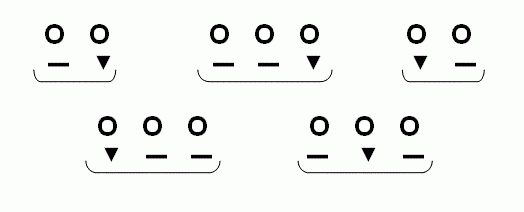
Other possible combinations can be analyzed as including the given basic groups : DDFD and FDF, illustrated as follows :

One way to illustrate this analysis is to apply it to the language. For example the word “puedo” maybe be analyzed as FD, and the word “escribir” as DDF. The phrase “puedo escribir” can be analyzed as formed by the groups FD and DDF. Like in the Spanish language the “o” and the “e” form a diphthong in the pronunciation, a possible interpretation could be :
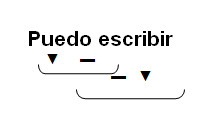
The example DDFD serves as an example of a dimension rarely related with rhythm, which is the architectural organization. It is usual to talk about architectural organization in many artistic disciplines as an aspect of the formal structure ; in poetry the syllables form words, words form verses, verses form stanzas, stanzas form songs, etc. In music, notes form motifs, motifs form sections, sections form semi phrases and phrases, phrases form themes and so on ; equally in dance, the narration, the theatre, cinema and much more. The same applies to the rhythmic conformation. For example, the famous first group of four notes of the beginning of Beethoven’s 5th Symphony could be analyzed as follows :
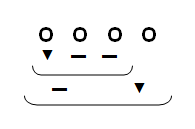
But when the following group appears, and even more, when it later begins with the first phrase of the theme, it can be seen that this first group and the second one conform a much larger group :
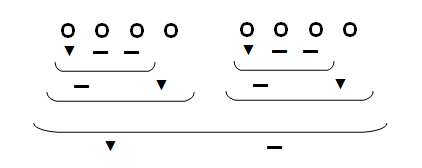
This grouping is rhythmic, not simply a “formal” point of view of the musical shape. Of course, from the point of view of rhythm, it is indeed a shape, in the sense that Benveniste defines it. A shape of what is in movement, adaptable, fleeting. It is a rhythmic group of a superior level of organization.
Continuing with this idea, the first verse of the 20th Poem of Pablo Neruda (Neruda, 2002), can be analyzed in the following manner :

Puedo escribir los versos más tristes esta noche.
[Tonight I can write the saddest lines.]
The word “tristes” is the most important event of the verse, as it is the only one which is prioritized in the three analyzed levels. Later, this verse gets grouped with the following one (or with part of it) in a superior level, and so on until it reaches a level that includes the entire poem, if it is the case.
If classical dance moves are considered, it can be soon discovered that it is possible to describe them in this manner. For example, the sequence of glissade–jeté not only forms a very evident grouping but also, most of the times it is executed it takes the DF form. A pas de valse instead is usually FDD, the same as in most of the times a pas de bourrée. A longer sequence of steps can also be analyzed in this manner, like the combination including pirouettes in which these ones are prepared by chasses, pas de bourrées, poses, among others. In these sequences, higher order levels of organization take part and the accent practically always falls over the pirouettes. Later on specific analysis of movement sequences are included.
These two concepts have a great power in analysis tools, as they allow a formalization independently of the number, the repetition, the regularity and the recurrence, and lightens up aspects of the rhythmic experience that in another way would remain in the darkness. A consequence of this analysis is that it describes how in a linear sequence of events, simultaneous structures are organized that link elements separated in time and that apparently do not influence each other. Meyer points it out like this, always speaking in terms of music : “(a melody, a series of notes) ...is not perceived as an independent series of units placed like beads in a mechanical manner… instead like an organic process in which the more smaller rhythmic motifs… also function as essential parts of a greater rhythmic organization” (COOPER & MEYER, 2000, p. 10).
Rhythm and metric
There are authors that refer to the metric, like J. Dalcroze, “The metric created by the intellect arranges in a mechanical manner the succession and the order of the vital elements and their combinations, while as the rhythmic assures the integrity of the essential principles of life. The measure comes from the reflection and the rhythm from the intuition.” (DALCROZE, 1965, pág. 164) The same thing occurs with the rhythm as there are no treatises about dance definitions or descriptions of the phenomena. Paul Hindemith, in his manual about training for musicians, characterizes this like the difference between rhythm and metric :
Even in series of sounds identical in all aspects, that repeat at equal time lapses, the ear tends to perceive regular groupings ; it grants certain sounds more importance than to others and listens the complete series as a wave between accentuated times and non-accentuated ones. This class of accents (metric accents), that is determined by our sensitivity and not by any other objective difference between the same sounds, is essentially different from the other class of dynamic accent… which is caused by an increase in the force.. The music, in general, is composed in such a way that our perceptive ability cannot doubt where the metric accents should fall : proportions of rhythmic duration, curves of melodic lines and the distribution of the harmonic functions serve as a guide for our analytical perception. But when these entire guides are missing, like in the regular series of identical sounds previously mentioned, we have a certain freedom to direct our perceptive listening : we can imagine such series as subdivided in groups of two or three tempos. In groups of two tempos, one of them gives the impression of been accentuated (Arsis), while as in the other one it seems as a non accentuated relaxation (Thesis). The group can start with any one of them. In groups of three tempos the accent is perceived over one of the three tempos while the other two remain non accentuated. (HINDEMITH, 1946, pág. 93)
This long quote reminds about the phenomenon of the “subjective rhythmization” of Fraisse which appears in the point 3.4. At first, this appears to be a contradiction : what Fraisse takes as an example of rhythm, Hindemith shows it as an example of metric, and both state that metric and rhythm are two different matters. Furthermore, Hindemith talks about group in relation to the metric, the same as Fraisse and Meyer do it in connection to the rhythm.
Fraisse cites various authors in his book : Riemann according to whom “…the metric quality derives from the differences in accentuation and the rhythmic quality of that in duration”, (as if the accent did not form part of the rhythmic phenomena) ; A. Souris, for whom the written measure exists, as a silent reference point, and the heard measure, as a rhythmic form ; and N. Lacharte, who claims that both can coincide, as this is the case of the dances. (FRAISSE, 1976, p. 114)
Also Manuel García Martínez, referring to the production, emphasizes the importance of what he refers to as “rhythmic frameworks”, a phenomenon by which the “…mental trace of the rhythms of the first moments…turn into the reference point of the subsequent rhythmic progress…the appropriation of the staging’s development rhythm by the spectator, a memory of the immediately previous progress and the waiting of an ultimately progress.” [(GARCIA MARTÍNEZ, 1995) quoted in (PAVIS, 2000, pág. 156)]
This mental trace, according to the point of view of this essay, would not be only a printed image about the mind, but it would also include an action of the spectator, in this case by which the rhythm would be owned. It is of the same type as the one that Hindemith describes and that the listener makes about the series of identical sounds in all aspects.
When a choreographer or a dance teacher shows a sequence to a dancer, this sequence can naturally be or not be built in relation to a metric. As there is music without metrics, like the Gregorian chants, to give an example, there are also dances without metrics. But in the case it has metrics ; the one who normally “passes” the sequence does it by counting the metric accents of the musical measures, if there is music available or the metric accents of an imaginary music if there isn’t. In the later scenario, the measures are marked with claps, beats, or snaps with the fingers.
The continuous reference to music, counting or a series of sounds which “mark the time”, darkens the fact that the metric is an action in which all the involved ones take part : musicians, dancers and choreographers/teacher, at the moment of the execution. And it forms part of the sequence as much as the movements that compose it, so the performer executes it such as it executes those movements.
Going even further, it can be seen that the coincidences between rhythm and metrics are such that it can be stated that the metric is no other thing than a particular type of rhythm. When Hindemith wants to talk about the frequency in which the metric accents appear, he talks of the groups, which apparently would identify the measure as a rhythmic grouping which always starts in the accentuated part. But, which is the special characteristic of this rhythm which makes it be referred to as metric ? Precisely, the purpose for which it is used, is to measure the rest of the rhythms, allowing their organization either be executed by the same performer or by several ones. This concludes that in an execution of a musical piece or dance, and also theatre or poetic piece, if a metric is employed, there are a least two rhythms that execute simultaneously, one that has the function of measuring and organising ; and the other one which performs the rhythmic organization of the corresponding piece. Of course this metric can be expressed, like in the accompanying of the waltzes (which is what Lacharte refers to in the quote take by Fraisse), or cannot be expressed, like in many musical pieces in which there is a unheard written measure but that has the goal of organizing the orchestra instruments and that is only discovered if the director’s movements are observed.
Thus, the rhythm used as a metric, most of the times has regularity and simplicity suitable for its function. Formed by a pulse, that divides the time in equal parts, and the measure which is the frequency that accentuates a pulse to set up the metric accent, in one or various pulse subdivisions.
As it is a rhythm like any other one, it has architectonic organization into levels. The following graph is made up of arbitrary symbols to emphasise that it is a fact that can appear in various disciplines, at least in music, dance and poetry.
In the first chart, a system of measures is shown in two parts, making up two pulses for each accent. It is also possible to group these measures by two and form a type of super-measure, to determine in which one the super-accent is drawn. In the chart two, lower pulse levels are included, but there can be more. Each one of these levels can be divided into two or three parts, like it is shown in an example in the consecutive pulses of the chart. In the occidental or western musical measure indications only the accent, the pulse and the first subdivision are showed. Naturally others can exist, and in music, they are very usual. If the first subdivision is binary like the first part of the figure, the measure is called simple, and if it is ternary it is called compound.

The choice of the ‘pulse’ level depends on the context of the used metric structure, and it is not shown in the graph. Frequently in the course of a musical or choreographic piece the pulse transforms into subdivision, later into pulse, then into accent and so on. Normally this fact is not reflected in written nor specified in any manner. If a level is designated as a pulse that in the first graph is called ‘accent’ and the second super-accent is deleted, the measure transforms into a four-section measure with three subdivision levels.
In the following chart, the measure is sketched in three sections. The same way as in the previous graph, in the first section the measure is simple and in the second one it is compound. The second subdivision could also be ternary in the compound measure, both in this case as in the previous one ; it has not been included due to space reasons.
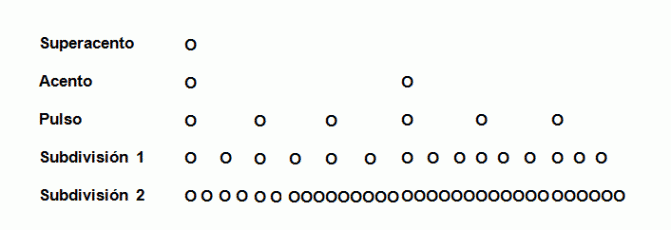
To conclude, it would be interesting to point out several things that sometimes create confusion.
Firstly, the metrics can exist in absence of any other stimulus, like an entirely private activity. It is due to that type of action that a soloist musician executes the metric of the performed pieced or an orchestra director directs or a dancer dances, in absence of music.
Although this observation is redundant as it is a characteristic of all the rhythms, it is interesting to point it out in relation to the music, as many artists consider it as an external fact or as an “intellectual” product. Secondly, the metric does not imply any exact temporal regularity, nor an invariable tempo. The frequency of the pulses and the metric accents can vary from an abrupt duration or a gradually one by one, and continues having a metric with such precision that it can be written in a detailed score of a musical piece even though all these changes are taking place. Lastly, a music can be “composed in such a way that our perceptive ability cannot doubt over where do the metric accents should fall” as Hindemith points out, and that, does not guarantee that the listener perceives or takes part in it.
References
ARAIZ, O. (25 de Julio de 2007). Entrevista sobre el ritmo. (C. BARRETTA, L. MIRAMONTES, & A. ZORRILLA, Entrevistadores)
ARNHEIM, R. (1962). Arte y Percepción Visual . Buenos Aires : EUDEBA.
BACHELARD, G. (2000). La Formación del Espíritu Científico. México : Siglo XXI.
BARBIERI, D. (1992). Questioni di Ritmo. Obtenido de Daniele Barbieri : http://www.danielebarbieri.it/downloads.asp
BARRETTA, C., MIRAMONTES, L., & ZORRILLA, A. (2013). Ritmando Danzas. Buenos Aires : Autores de Argentina.
BENVENISTE, E. (1966). La notion de rythme dans son expression linguistique. Problèmes de linguistique générale , 133.
BORDAS, É. (1 de mayo de 2007). Le rythme de la prose. Recuperado el 27 de agosto de 2011, de Semen [En ligne], 16 | 2003 : http://semen.revues.org/2660 et http://rhuthmos.eu/spip.php?article749
COOPER, G., & MEYER, L. (1960). The Rhythmic Structure of Music. Chicago : University of Chicago Press.
DALCROZE, E. J. (1965). El ritmo, la música y la educación. Suiza : Edición Foetisch.
DESSONS, G., & MESCHONNIC, H. (1998). Traité du rythme. Des vers et des proses. Paris : Dunod.
FRAISSE, P. (1976). Psicología del ritmo. Madrid : Ediciones Morata.
HINDEMITH, P. (1946). Adiestramiento Elemental para Músicos,. Buenos Aires : Ricordi.
LANGER, S. (1953). Form and Feeling : A Theory of Art. New York : Scribner’s.
MESCHONNIC, H. (1982). Critique du rythme. Lagrasse : Verdier.
MEYER, L. B. (1957). Emotion and Meaning in Music. Chicago-Londres : University of Chicago Press.
MICHON, P. (2 de junio de 2010). Faut-il conserver le concept traditionnel de rythme ? . Recuperado el 20 de mayo de 2012, de Rhuthmos : http://rhuthmos.eu/spip.php?article4
Neruda, P. (2002). Veinte Poemas de Amor y una Canción Desesperada. Bogotá : Norma.
PAVIS, P. (2000). El análisis de los espectáculos. Buenos Aires : Paidós.
SAUVANET, P. (28 de octubre de 2012). La question du rythme dans l’œuvre d’Henri Maldiney : approche et discussion. Recuperado el 15 de 3 de 2013, de Rhuthmos : http://rhuthmos.eu/spip.php?article736

